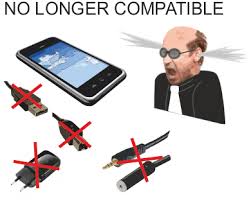The idea is an extension of the mass production and was described by Bernard London in 1932, who saw it as a means to overcome the Depression. From 1954, it became Brooks Stevens hobbyhorse. It was eagerly taken up by the producers.
 The industry makes products with a limited lifespan. This ensures that the business can continue to sell. Design and technological innovation to products quickly look outdated. Maintenance expenses are running quickly, the manufacturers’ after-sales service stops. Restore is at least as expensive as replacing, often more expensive.
The industry makes products with a limited lifespan. This ensures that the business can continue to sell. Design and technological innovation to products quickly look outdated. Maintenance expenses are running quickly, the manufacturers’ after-sales service stops. Restore is at least as expensive as replacing, often more expensive.
The Phoebus cartel
Planned Obsolescence (The light bulb conspiracy)
The Phoebus cartel was established in 1921-1923. Incandescent lamp manufacturers such as Philips, General Electric, Osram agreed (with heavy penalty clauses) to limit the life span of light bulbs in order to be able to sell more. This was a brake on technological evolution. The industry standard of 2,500 hours in 1924 would eventually decrease by 1940 to 1,000 hours of use. WW II disrupted this conspiracy.
In the Livermore (California) fire station there is a lamp (from the Shelby Electric Company) that was installed in 1901 to replace an old kerosene lantern. She had about 875,000 hours of burning (110 years).
Ivan Illich (1926 - 2002, fascinating and worth reading) believed that clear limits should be set to rapid forced change and innovation of products. These practices ensure the growth of the economy, but also ensure huge waste of resources and energy. Hence his then already ecologically sustainable vision for consumer products: "This means that products must keep up longer, need to be repaired or restored appropriate and be much less prone for fashions or trends."
With all sorts of life limitations is actually produced, intended conscious waste. Meant to after a relatively short time no (longer, enough) to function anymore. And to be dumped and (sometimes annually) replaced by a newer model.
This is forced by alternately changing cycles of new software, data structures, by the number of recharge cycles of batteries - and new hardware, through the conscious design of consumables products, even by installing chips to stop after a certain period of operation or a predetermined number of copies. Or even will indicate that a cartridge is empty, weather there is ink / toner in it or not.
Previously, stockings, cars, washing machines... were nearly indestructible, they were easily 25 years.
In planned decay is recovering of technically obsolete equipment often more expensive than a new product.
In systemic aging in hardware and software, new versions are not “backward compatible“ causing a vicious cycle of mandatory upgrades. Stylistic aging plays with design and fashion.
The production is a function of realizable profit, and not in terms of use and durability.
More info can be found on the Internet under the search words: Planned Obsolescence.
Money is no object. It's director. (Harry De Jong)
"Is this the bill for the repair, or a proposal to take over your business'
